Fact Sheet FS1249
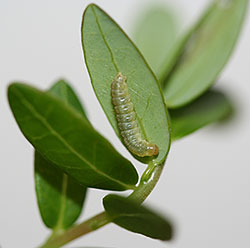
Figure 1.
Sparganothis fruitworm, Sparganothis sulfureana (Clemens) (Lepidoptera: Tortricidae), is a major pest of cranberry in New Jersey, Massachusetts and Wisconsin (USA) and an emerging pest in British Columbia (Canada). Larvae feed on foliage and developing fruit and can devour multiple fruit throughout their development.
Distribution
Sparganothis fruitworm is native to the area; the insect is commonly found in New York and has also been reported in Nova Scotia, Ontario, and Alberta in Canada. It is supposedly a generalist, with a wide range of wild and cultivated plants as potential hosts. However, in New Jersey and Massachusetts, the insect mainly feeds on cranberry and yellow loosestrife (Lysimachia terrestris), a weed common in cranberry bogs.
Life Cycle
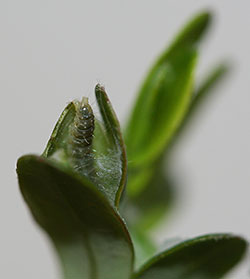
Figure 2.
The species has two generations per year: an overwintering generation and a summer generation. Early-instar larvae hibernate and become active again in spring, feeding on new growth (Figure 1). They camouflage themselves by webbing leaves and then entire uprights together with silk; they feed and also pupate in this enclosure (Figure 2). Adults appear in late June and early July (Figure 3). Females lay eggs that hatch within 9–12 days into small larvae. These larvae of the summer generation feed on foliage and developing fruits for 30–40 days and then pupate in damaged fruits. The pupal period lasts 7–12 days. Second-generation adults appear in mid-August and September. Females lay eggs within two days and early-instar larvae go into hibernation by mid- to late September.
Identification
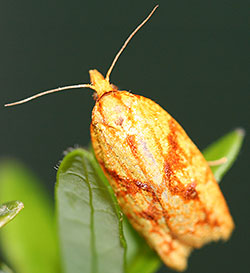
Figure 3.
Egg-masses consist of 20–50 eggs that are laid on the upper side of cranberry leaves or berries and can also be laid on weeds. The eggs are oval and pale yellow-green; when ready to hatch, the heads of the larvae may be seen through the egg shell. First-instar larvae have a black head and resemble black-headed fireworms. They are 1–2mm (1/16") long. Second-instar larvae have a dark brown head capsule and in later instars, the head capsule turns yellowish brown. The larval body color varies, but mostly, the dorsal half is darkish green and the ventral half is paler. Larvae can also be whitish-yellow or butterscotch-yellow. There are pale spots on the back (Figures 1 and 2). Full-grown larvae can reach a size of 14.5mm (37/64"; males) and 16.5mm (21/32"; females). When disturbed, the larvae wriggle vigorously. The pupa is dark brown to black and is 7.5–10mm (5/16-6/16") long. Male and female moths look similar, and the average length of the forewing is 7.7mm (5/16") for females and 7.0mm (9/32") for males. The adults have yellow wings with magenta-colored scales that form a V-shaped marking. When the wings are folded, the markings make an X-shaped mark on the back (Figure 3).
Damage
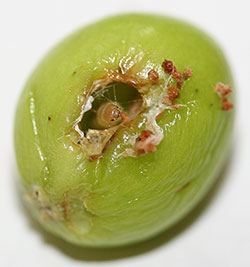
Figure 4.
Larvae feed on foliage and developing cranberries. First generation larvae feed mainly on new plant growth. They web leaves and later entire uprights together with silk and feed on the leaf surface within this enclosure (Figure 2). They may also feed on developing blossoms. Second generation larvae hatch during fruit set and mature in late summer. They cause the most damage as they feed not only on foliage, but also on developing berries (Figure 4). Larvae feed on the outside of berries and enter the berries to devour the developing seeds. Small larvae fill the berries with frass, causing it to turn red. This notably distinguishes attacked berries from the surrounding healthy ones; the unripe berries are still green. Larger larvae dispose of the frass and leave fruits cleanly hollowed out (Figure 5). They can create feeding holes as large as 1–3mm (1/16–1/8") and do not cover them with silk. The berries are sometimes webbed together with other berries or uprights. Infestations tend to be patchy and appear mainly on bog margins.
Fruit damage by Sparganothis fruitworm is similar to cranberry fruitworm damage, but as the management of these two pests differs, it is important to distinguish the two. In contrast to late-instar Sparganothis fruitworm, cranberry fruitworm fills the fruits with frass, turning the interior brown and mushy.
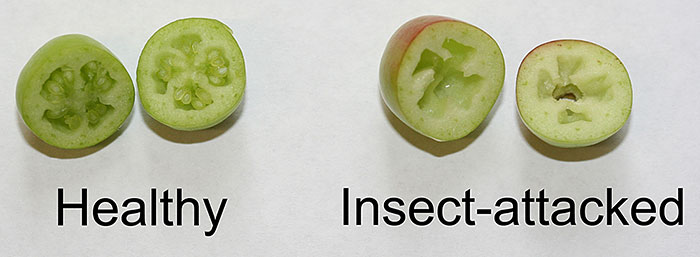
Figure 5.
Management
Control of Sparganothis fruitworm is difficult. In Massachusetts, the insect is reportedly resistant to certain organophosphate insecticides. Thus, organophosphates should be used with care, and it is best to rotate insecticides with different modes of action. The cranberry variety Ben Lear appears particularly susceptible to Sparganothis fruitworm; larvae may enter the large, early season berries sooner, resulting in an increased protection against pesticides. Also, parasitoid natural enemies appear less able to reach the insects in the large fruits with their small ovipositors. Late flooding has not been shown to be effective against Sparganothis fruitworm.
Once the water is removed from the beds and until bloom, the insect is monitored with sweep net sampling. The action threshold for spraying with selective pesticides is set at a very low count (1.5 larvae per 25 sweeps), as due to the webbing of leaves and uprights, not all larvae can be retrieved by sweeping. Visual inspections for webbing are also recommended.
From the beginning of bloom, adults can be monitored using pheromone Delta traps. Sex pheromone lures that attract male adults are commercially available. As there is no direct correlation between trap captures and amount of damage, visual observations of leaf and fruit injury remain necessary. One trap should be placed every 10 acres and traps should be checked weekly in order to count the number of moths.
If spraying when bees are present, only insect growth regulators (IGRs) and Bt-based products can be used. If trap counts indicate a low Sparganothis fruitworm population, a single pesticide application post-bloom is recommended two weeks after peak pheromone trap catches (usually in the second week of July). If trap counts indicate a high insect population, an IGR can be applied during bloom, and another pesticide after bloom.
For both generations, the most effective treatments target early instar larvae. Larger larvae are very difficult to manage post-bloom, but they are commonly attacked by their natural enemies, predators and parasitoids. Especially egg parasitoids (Trichogramma spp.) and the parasitic tachinid fly, Erynnia tortricis (Coquillett), seem to be effective. If conserved, these natural enemies can regulate Sparganothis fruitworm populations. The use of selective insecticides is recommended, as in areas where broad-spectrum sprays are used, natural enemies can be eliminated and Sparganothis fruitworm outbreaks are more likely.
A phenological degree-day (DD) model may help to determine when to spray. DDs are heat units that can be used to predict insect development, as insect growth is linked to ambient temperatures rather than calendar days. Daily DDs can be determined using an online DD calculator or by using a look-up table specific for Sparganothis fruitworm. They depend on the insect's lower and upper temperature threshold for larval development: 10.0 and 29.9°C (49.9 and 85.8°F) respectively. DD accumulations can be linked to Sparganothis fruitworm growth. For instance, in Wisconsin, the first-generation egg hatch period is, on average, between 895 and 1,890 DDs after March 1. Spraying during this biological "window of time" may reduce the Sparganothis fruitworm population.
Literature Cited
Photo credits: Elvira de Lange, Department of Entomology, Rutgers University
November 2015
Copyright © 2024 Rutgers, The State University of New Jersey. All rights reserved.
For more information: njaes.rutgers.edu.
Cooperating Agencies: Rutgers, The State University of New Jersey, U.S. Department of Agriculture, and Boards of County Commissioners. Rutgers Cooperative Extension, a unit of the Rutgers New Jersey Agricultural Experiment Station, is an equal opportunity program provider and employer.

